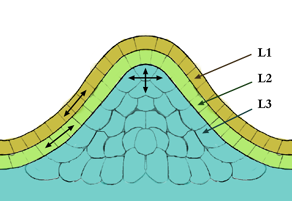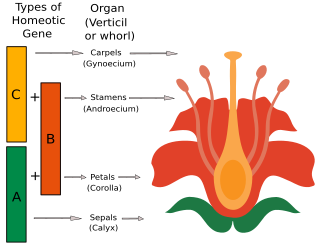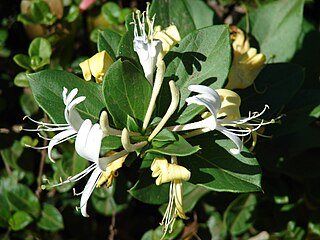
In cell biology, the meristem is a type of tissue found in plants. It consists of undifferentiated cells capable of cell division. Cells in the meristem can develop into all the other tissues and organs that occur in plants. These cells continue to divide until they become differentiated and lose the ability to divide.

Antirrhinum is a genus of plants commonly known as dragon flowers or snapdragons because of the flowers' fancied resemblance to the face of a dragon that opens and closes its mouth when laterally squeezed. They are also sometimes called toadflax or dog flower. They are native to rocky areas of Europe, the United States, Canada, and North Africa. Antirrhinum species are widely used as ornamental plants in borders and as cut flowers.

Phalaenopsis, also known as moth orchids, is a genus of about seventy species of plants in the family Orchidaceae. Orchids in this genus are monopodial epiphytes or lithophytes with long, coarse roots, short, leafy stems and long-lasting, flat flowers arranged in a flowering stem that often branches near the end. Orchids in this genus are native to India, Taiwan, China, Southeast Asia, New Guinea and Australia with the majority in Indonesia and the Philippines.

Cyclamen is a genus of 23 species of perennial flowering plants in the family Primulaceae. In English, it is known by the common names sowbread or swinebread. Cyclamen species are native to Europe and the Mediterranean Basin east to the Caucasus and Iran, with one species in Somalia. They grow from tubers and are valued for their flowers with upswept petals and variably patterned leaves.

Floral symmetry describes whether, and how, a flower, in particular its perianth, can be divided into two or more identical or mirror-image parts.

Commonly known as hellebores, the Eurasian genus Helleborus consists of approximately 20 species of herbaceous or evergreen perennial flowering plants in the family Ranunculaceae, within which it gave its name to the tribe of Helleboreae. Many hellebore species are poisonous.

The ABC model of flower development is a scientific model of the process by which flowering plants produce a pattern of gene expression in meristems that leads to the appearance of an organ oriented towards sexual reproduction, a flower. There are three physiological developments that must occur in order for this to take place: firstly, the plant must pass from sexual immaturity into a sexually mature state ; secondly, the transformation of the apical meristem's function from a vegetative meristem into a floral meristem or inflorescence; and finally the growth of the flower's individual organs. The latter phase has been modelled using the ABC model, which aims to describe the biological basis of the process from the perspective of molecular and developmental genetics.

Linaria vulgaris, the common toadflax, yellow toadflax or butter-and-eggs, is a species of flowering plant in the family Plantaginaceae, native to Europe, Siberia and Central Asia. It has also been introduced and is now common in North America.

A flower, also known as a bloom or blossom, is the reproductive structure found in flowering plants. Flowers consist of a combination of vegetative organs – sepals that enclose and protect the developing flower, petals that attract pollinators, and reproductive organs that produce gametophytes, which in flowering plants produce gametes. The male gametophytes, which produce sperm, are enclosed within pollen grains produced in the anthers. The female gametophytes are contained within the ovules produced in the carpels.

Cymbalaria muralis, commonly called ivy-leaved toadflax or Kenilworth ivy, is a low, spreading, viney plant with small purple flowers, native to southern Europe. It belongs to the plantain family (Plantaginaceae), and is introduced to many other temperate locations. The flower stalk is unusual for seeking light until it is fertilized, after which it grows away from the light. Other names include coliseum ivy, Oxford ivy, mother of thousands, and wandering sailor.

Impatiens repens, the Ceylon balsam, yellow impatiens, or creeping balsam, is a species of flowering plant in the family Balsaminaceae, from Sri Lanka. As the Latin name repens indicates, it is a low-growing plant with a creeping habit. This evergreen perennial can be found in wet-zone rain forests. Growing to 50 cm (20 in) tall and broad, it has small kidney-shaped leaves borne on red stems, and hooded yellow flowers in summer and autumn. It can be seen cultivated in gardens as an ornamental plant. In temperate zones it must be protected from temperatures below 10 °C (50 °F), so must be grown under glass during the winter months, It requires a sheltered position in partial shade.
Pseudorontium is a genus of flowering plants with one species, Pseudorontium cyathiferum, a New World snapdragon known by the common names dog's-mouth and Deep Canyon snapdragon. It is native to the deserts of northern Mexico and adjacent California and Arizona. It is an annual herb producing a hairy, erect, non-climbing stem with many oval-shaped leaves. The solitary flowers are dark-veined deep purple and white, often with some yellow in the throat, and are about a centimeter long. Previously considered to belong among the New World Antirrhinum species, it is now considered the sole member of the related genus Pseudorontium.

Neogaerrhinum filipes, synonym Antirrhinum filipes, is an annual species of North American flowering plant in the family Plantaginaceae. It is known by the common name yellow twining snapdragon. This herbaceous plant is native to deserts of the southwestern United States and northern Mexico, where it is common.

Haloragis erecta, the shrubby haloragis, toatoa or erect seaberry, is a plant species that is endemic to New Zealand.

The Antirrhineae are one of the 12 tribes of the family Plantaginaceae. It contains the toadflax relatives, such as snapdragons.

Floral scent, or flower scent, is composed of all the volatile organic compounds (VOCs), or aroma compounds, emitted by floral tissue. Other names for floral scent include, aroma, fragrance, floral odour or perfume. Flower scent of most flowering plant species encompasses a diversity of VOCs, sometimes up to several hundred different compounds. The primary functions of floral scent are to deter herbivores and especially folivorous insects, and to attract pollinators. Floral scent is one of the most important communication channels mediating plant-pollinator interactions, along with visual cues.

Anthochlor pigments are a group of secondary plant metabolites and with carotenoids and some flavonoids produce yellow flower colour. Both, chalcones and aurones are known as anthochlor pigments. Anthochlor pigments serve as UV nectar guides in some plants. Important anthochlor pigments accumulating plants are from the genus Coreopsis, Snapdragon or Bidens ferulifolia.

Pelorism is the term, said to be first used by Charles Darwin, for the formation of 'peloric flowers' which botanically is the abnormal production of radially symmetrical (actinomorphic) flowers in a species that usually produces bilaterally symmetrical (zygomorphic) flowers. These flowers are spontaneous floral symmetry mutants. The term epanody is also applied to this phenomenon. Bilaterally symmetrical (zygomorphic) flowers are known to have evolved several times from radially symmetrical (actinomorphic) flowers, these changes being linked to increasing specialisation in pollinators.
Not to be confused with Rosemary Carpenter Fitzgerald.

Antirrhinum hispanicum, the Spanish snapdragon, is a species of flowering plant belonging to the genus Antirrhinum that is native to southeastern Spain.































